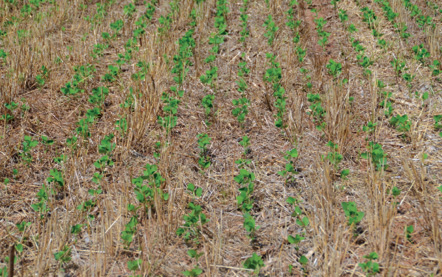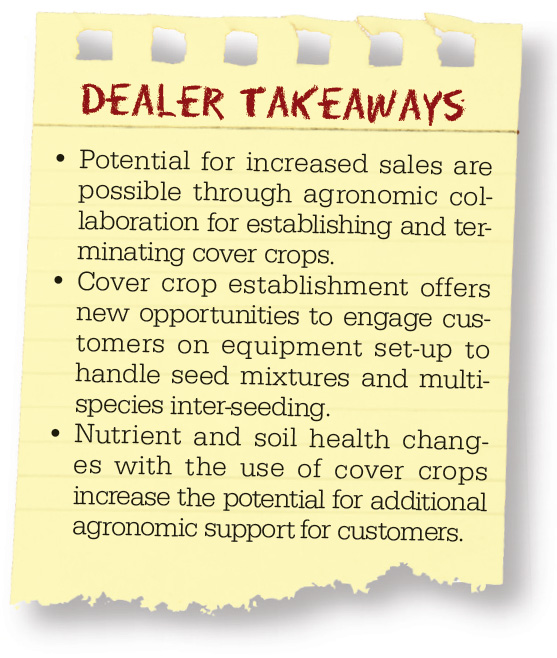
Terminated or harvested small grains account for nearly 70% of the cover crops being used by farmers reporting to a CTIC/SARE Cover Crop Survey for 2013-14. Here, no-till soybeans thrive in triple-digit Oklahoma temperatures, fed by soil moisture protected by last spring’s wheat crop.
While the use of cover crops is not new, interest in the benefits they can produce is growing. U.S. farmers are on track to plant cover crops in their normal rotations to the tune of more than 20 million acres by 2020. The interest in keeping something growing on fields year round is rooted in farmers’ search for increased yields, better management of natural rainfall, reduced soil erosion, boosting soil organic matter and better overall “soil health.”
The trend really began in the Upper Mississippi River Watershed with the drought of 2012, when fields covered with small grains and other plants retained sufficient moisture during the blistering, dry summer to provide 11 bushels per acre corn yield increases over fields without a cover. Soybeans, too, showed yield advantages that year when planted into cover crops.
Overall, statistics concerning the impact of the 2012 drought on crop yields in Nebraska, Kansas, South Dakota, Missouri, Iowa, Illinois and Indiana showed the use of cover crops boosted corn yields by 11% and soybean yields by 14.3%. Farmers across the U.S. responding to a survey concerning the use of cover crops that year, who had side-by-side field comparisons to report, said they saw a 9.6% increase in yields for corn planted into covers, and 11.6% soybean yield increases due to cover crop moisture retention.
Since that time, farmers reporting they have established a cover crop on their farms for the first time have jumped dramatically, says Missouri University’s Rob Myers, who works closely with the North Central SARE (Sustainable Agriculture Research and Education) program and the Conservation Technology Information Center (CTIC).
Growing interest in cover crops runs hand-in-hand with no-till farm management and crop rotations, and, as one might guess, the initial popularity of covers began in areas with regular and ample rainfall. West of the U.S. Highway 81 corridor, however, small grain stubble and terminated stands of wheat, rye and barley are helping irrigators reduce ground water pumping along the Ogallala Aquifer.
You May Also Be Interested In...
Case Study: When is Investing in a New Structure the Right Decision?
In this year's SOURCEBOOK Special Report, we went in-depth with 5 different scenarios examined in a format similar to Harvard Business Review case studies. In one case study, we explored how a consultant might approach a farmer questioning whether they should invest in a new building.
In the Southern Plains, where there is a cattle component, growers are seeding cover crops and paying for some of the establishment costs with limited grazing. In nearly all cases, proponents cite improved soil moisture and texture where cover crops are used. Those who have used them the longest will tell you a cover crop saves more moisture for cash crops in the long term than it costs in moisture to produce.
Information from SARE explains what a grower might expect from the first year of planting a cover crop with the following benefits:
- Deep rooting cover crops lead to deeper rooting cash crops.
- Residue blankets reduce evaporation.
- Possible changes in mychorrhizae (fungi) and overall soil biology.
- Additional first-year benefits often include cash crop yield increases immediately following the use of a cover crop, although those increases come at the cost of establishing and terminating the cover.

Longer term benefits according to CTIC and SARE include:
- Increased organic matter, which leads to improved rainfall infiltration and better year-to-year retention of moisture in the soil profile
- Better soil health
- Less restriction to root growth
What’s Being Planted?
In winter growth areas, fall-planted cover crops include cereal rye, oats, tillage radishes, annual ryegrass, canola and hairy vetch.
Spring-seeded cover crops often include spring triticale, oats, Austrian peas, dwarf rapeseed and clovers.
Summer covers include sorghum Sudan grass, grain sorghum, foxtail millet and buckwheat.
Ag Retailers Role in Cover Crops
As part of the 2013-14 SARE/CTIC cover crop survey, respondents were asked how the ag retail community could help and benefit from actively planning to serve growers using cover crops. With nearly 60% responding, the suggestions included:
- Help assess and understand soil changes resulting from cover crop use
- Help to adjust nutrient management plans to account for cover crop use
- Provide cover crop termination advice and services
- Provide cover crop seeding services
- Advise farmers on cover crop selection
- Encourage farmers to plant cover crops
Of the several thousand respondents to SARE’s annual cover crop survey, 69% are planting winter cereal grains, 51% report planting brassicas and legumes, 50% use annual grasses in their cover crop management, 31% use multi-species mixes, 25% use a two-species mix, and 19% plant summer annual broadleaf species.
Farm consultant Bryan Vincent, whose business includes more than 100,000 acres of central Oklahoma cropland, says dealers could begin to take part in the cover crop movement by helping their customers with various equipment set ups — particularly for simultaneously seeding different size seed found in various cover crop mixtures.
“The peas need to be planted deeper than other seeds and are tough to plant without splitting them with equipment designed for smaller seeds,” he explains. “So, we have some growers running row units set for peas and 7.5 inches over another unit operating much shallower with smaller seed species.”
How Are They Planted?
Data from the CTIC/SARE cover crop survey shows in 2013-14, 46% of the respondents reported drilling their cover crops, while 24% used broadcast methods with light cultivation. Another 12% broadcast cover crop seeds to the surface either during the cultivation stages of a cash crop or directly to fields behind harvesters. Fourteen percent hired aerial applicators to seed their cover crops, and only 3% reported planting with a corn or soybean planter. Those planting with liquid manure accounted for only 1% of those reporting.
What is ‘Soil Health?’
Today’s public conversation is full of buzzwords and catch phrases that are nebulous at best but when studied for specific meaning, fall far short of precision. Because we’ve used the phrase “soil health” several times in this article, we want you to know it does have a specific, measurable meaning.
“Soil Health” as it applies to cover crop benefits is measured by a process developed by Rick Haney of USDA’s Blacklands Agricultural Research Service station in Temple, Texas.
The process analyzes soil and takes into account the relationship of microbial activity to the amount of soil organic carbon and nitrogen. This system renders a soil health calculation ranging from 0 to greater than 50, with a higher number indicating better “soil health.”
In the first several years of USDA’s study of cover crops from 7 research areas distributed across the U.S., soil health scores showed a slight increase within the first year or two of cover crop use as indicated by higher biological assessment values.
In most cases, the median seeding cost for a cover crop ran about $25 per acre, and about another $12 per acre in labor and equipment to contract out planting of the cover crop.
How Are They Terminated?
While cover crops add carbon to the soil and hold erosion at bay as they grow, most have to be terminated to make way for cash crops, which generates demand for several lines of goods and services from ag retailers looking to support the growing movement to covers.
Survey results show 45% of cover crops are terminated with herbicides, another 20% are tilled, while 19% are planted to be killed by frost. Mowing accounts for 10% of cover crop termination, while mechanical roller-crimping accounts for only 1%.
Incentives for Cover Crops
Most proponents of cover crops say the benefits of keeping the ground covered and adding carbon to the soil throughout the year are great enough to pursue without financial incentives from government or conservation agencies. However, there are local grants and incentives to try the practice.
Also, USDA offers programs by which cover crops can be included in crop insurance plans and, through the USDA-NRCS, in some states there are special cover crop initiatives offered through the Environmental Quality Incentives Program (EQIP).
In the October/November issue, we’ll look at new and popular equipment used in establishing cover crops.







Post a comment
Report Abusive Comment